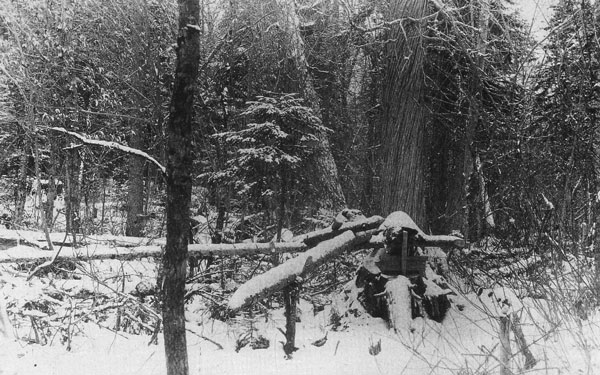B A C K T H E N

A deadfall trap, near Houlton, about 1890. Note the large, clear cedar beyond—shingles were long Aroostook’s main cash crop. Charles West, of Houlton, wrote about trapping with deadfalls—indeed, this is likely his trap:
The dead fall, or wooden trap, if properly built and set with sufficient heft upon the fall piece, will do a good business… A large log, a down pine stub, a square cut off fir or spruce tree, is usually selected to build upon. Dry cedar splits are provided a foot long, and a half to three-fourths of an inch thick, for the house which is shaped like a V… The fall piece and bed piece are made from one tree and fit together nicely, the fall being from six to ten feet long…the outer end may be supported by resting in the fork of a small tree; if not, a forked stick is provided… Upon this fall piece rests the weight of logs… that pin down and kill the animal. Next the spindle, or bait stick, upon the end of which is fastened the bait…
This photo was identified as depicting a bear trap; certainly the rock and the two logs atop the fall pole indicate that it is meant for more than sable or fisher. A stump provided a base when the ground was frozen. A friend of West’s, evidently using a larger design, simultaneously caught a sow bear and her two yearling cubs. Mother and one cub were killed, the other cub, unharmed, was stuck. Deadfalls offered certain advantages over metal traps. They did not have to be lugged in for miles, and they cost nothing but time (“and the trapper’s whole life is given over to time”). Skunks killed in a deadfall did not spray. Last but not least, deadfalls were humane.
Bears were trapped, not hunted—although extraordinarily powerful, bears are very shy. (Patten lumberman Luther Rogers spent a lifetime in the woods and never saw a bear.) Aside from the odd livestock killer or beehive raider, bears avoided human contact. To some humans, however, killing bears was both a profession and an obsession. The exploits of the bear killers were celebrated in the pages of the Industrial Journal with only the occasional mention of the piteous crying of orphaned cubs found beside their mother’s corpse revealing a chink in Editor Blanding’s bravado.
In his classic autobiography, Hancock County poacher Wilbur Day credited Sam Day, his father, with having killed more bears—284—than any other man in Maine. Honors for the top bear-slaying couple surely went to Mr. and Mrs. John Varney, of Vanceboro, with 400 kills to their credit by 1887.5 Sam Day used deadfall traps almost exclusively, shooting only cubs. Probably most hunters used steel traps. (A leading trap manufacturer was New York’s Oneida religious community.) Traps were usually chained to a log called a “clog.” Big bears could drag a clog for miles, sometimes even climbing a tree with one. The loss of the trapped foot was not uncommon.
Zina B. Pennell, the old Whitneyville hunter, recently put out some traps near Bear Brook… With his bear dog, Jim, he returned after a couple of days… While hidden from view…a lively rattle of trap and chain was heard, accompanied by a howl from the dog, who was seen for a moment above the scrub, performing speedy evolutions in the air. With ready rifle Zina hurried forward but was surprised to see nothing save a limp and subdued dog beside his trap, which contained a part of a bear’s foot … A chewed toggle, broken trees and disturbed soil indicated that the bear had been caught some time and Mr. Pennell thinks the foot was nearly twisted off, and the blow given the dog completed the job… – The [Bangor] Industrial Journal, June 2, 1893.
A bearskin was worth $3 and up—that of an “old settler” or “cow-lifter,” in the fall, might bring $25. When in force, the state bounty was $5, paid in receipt of nose and ears (a deer nose looked much like a bear nose). In 1887, of 560 bounties paid, Greenville hunters collected 305. A limited market existed for bear meat, and barber shops bought bear-grease oil. Cubs were sometimes captured for sale to Indian medicine shows or menageries, or for display in city parks such as Portland’s Deering Oaks.
Last Saturday [from] the Patten and Mattawamkeag stage…a large bear and two cubs were seen to cross the road… On the stage were Mr. M. Averill, a Boston gentleman, Dr. S. W. Bragg, of Lincoln, and several Indians on their way to Loveland’s drive… The whole party made a grand charge on the old bear who was terrified…and took to the woods. A bullet from a small revolver had no effect… The cubs climbed into a tall tree, and Newall Francis, one of the Indians, mounted a tree that stood near the ones the cubs were in…and [with a long pole] pushed them off the tree and they fell some sixty feet to the ground… They were purchased by Dr. Bragg, and he intends to educate them. –The [Bangor] Mining and Industrial Journal, May 11, 1883.
Text by William H. Bunting from A Days Work, Part 2, A Sampler of Historic Maine Photographs, 1860–1920, Part II. Published by Tilbury House Publishers, Gardiner, Maine. 800-582-1899
